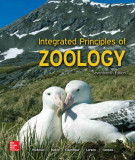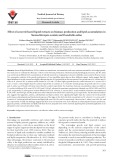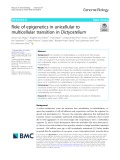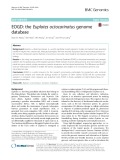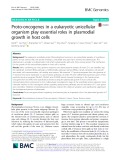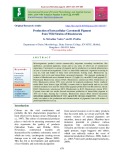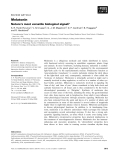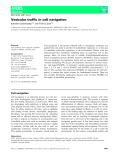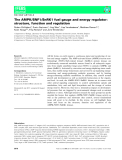
Unicellular organisms
-
Ebook "Cell-cell channels" covers the topic of cell-cell channels at all levels of biological organization, starting with bacteria and unicellular ciliates, via algal, fungal and plant cells, up to and including the diverse cell types of animals. We hope that this book will help update the traditional cell theory and will also stimulate new discussions concerning the basic units of life.
 331p
331p  ladongphongthanh1008
ladongphongthanh1008
 22-04-2024
22-04-2024
 4
4
 1
1
 Download
Download
-
Part 1 book "Integrated principles of zoology" includes content: Life - Biological principles and the science of zoology, the origin and chemistry of life, cells as units of life, cellular metabolism, organic evolution, the reproductive process, principles of development, architectural pattern of an animal, taxonomy and phylogeny of animals, unicellular eukaryotes, sponges and placozoans, cnidarians and ctenophores,... and other contents.
 418p
418p  muasambanhan05
muasambanhan05
 16-01-2024
16-01-2024
 4
4
 0
0
 Download
Download
-
Ebook "Cell cycle synchronization: Methods and protocols (Second edition)" provides detailed protocols on the theoretical background of cell cycle synchronization procedures and instructions on how to implement these techniques. The chapters in Cell Cycle Synchronization: Methods and Protocols, Second Edition cover subjects such as: physical fractionations including centrifugal elutriation of healthy and apoptotic cells, and nuclei of mammalian cells; large scale mitotic cell synchronization; chromosome formation during fertilization in eggs;...
 345p
345p  lucchinguyen
lucchinguyen
 28-12-2023
28-12-2023
 6
6
 2
2
 Download
Download
-
The study aims to evaluate the efficiency of SLFs on the biomass production, biochemical and physiological processes; and the study was carried out at different SLF concentrations of selected seaweeds i.e. Kappaphycus alvarezii, Gelidiella acerosa and Turbinaria ornata. The comparative analysis of the growth performance of two unicellular green alga on three different organic media suggest that the liquid fertilizer from red seaweed was highly efficient than the SLF prepared from brown seaweed.
 18p
18p  lyhuyenthu
lyhuyenthu
 31-01-2023
31-01-2023
 6
6
 2
2
 Download
Download
-
The evolution of multicellularity is a critical event that remains incompletely understood. We use the social amoeba, Dictyostelium discoideum, one of the rare organisms that readily transits back and forth between both unicellular and multicellular stages, to examine the role of epigenetics in regulating multicellularity.
 30p
30p  viarchimedes
viarchimedes
 26-01-2022
26-01-2022
 12
12
 0
0
 Download
Download
-
Euplotes, a ciliated protozoan, is a useful unicellular model organism. Studies on Euplotes have provided excellent insights into various basic biological principles. We have recently sequenced the macronuclear genome of the common freshwater species Euplotes octocarinatus to provide novel insights into Euplotes genetics and molecular biology.
 6p
6p  vibeauty
vibeauty
 23-10-2021
23-10-2021
 9
9
 1
1
 Download
Download
-
The eukaryotic unicellular protist Plasmodiophora brassicae is an endocellular parasite of cruciferous plants. In host cortical cells, this protist develops a unicellular structure that is termed the plasmodium. The plasmodium is actually a multinucleated cell, which subsequently splits and forms resting spores. The mechanism for the growth of this endocellular parasite in host cell is unclear.
 14p
14p  viseulgi2711
viseulgi2711
 31-08-2021
31-08-2021
 13
13
 1
1
 Download
Download
-
Amoebozoa is a eukaryotic supergroup composed of unicellular and multicellular amoebic protozoa (e.g. Acanthamoeba, Dictyostelium, and Entamoeba). They are model organisms for studies in cellular and evolutionary biology and are of medical and veterinary importance.
 8p
8p  vijeeni2711
vijeeni2711
 30-06-2021
30-06-2021
 11
11
 1
1
 Download
Download
-
All sequenced eukaryotic genomes have been shown to possess at least a few introns. This includes those unicellular organisms, which were previously suspected to be intron-less. Therefore, gene splicing must have been present at least in the last common ancestor of the eukaryotes.
 11p
11p  viwyoming2711
viwyoming2711
 16-12-2020
16-12-2020
 18
18
 1
1
 Download
Download
-
Asymmetry during cellular division, both in the uneven partitioning of damaged cellular components and of cell volume, is a cell biological phenomenon experienced by many unicellular organisms.
 14p
14p  vijisoo2711
vijisoo2711
 27-10-2020
27-10-2020
 5
5
 0
0
 Download
Download
-
Microorganisms produce certain commercially important secondary metabolites like antibiotics, carotenoid pigments, toxins and so on, some of which are of commercial importance. Carotenoid is a group of pigment and its production is a natural phenomenon in case of certain microorganisms. Yeast is a unicellular eukaryotic organism occurring in soil, air, feed and fodder of dairy farm environment. Among yeast, Rhodotorula sp. produces both extra and intracellular carotenoid pigments.
 5p
5p  trinhthamhodang7
trinhthamhodang7
 31-08-2020
31-08-2020
 16
16
 2
2
 Download
Download
-
Melatonin is a ubiquitous molecule and widely distributed in nature, with functional activity occurring in unicellular organisms, plants, fungi and animals. In most vertebrates, including humans, melatonin is synthes-ized primarily in the pineal gland and is regulated by the environmental light⁄dark cycle via the suprachiasmatic nucleus.
 26p
26p  inspiron33
inspiron33
 25-03-2013
25-03-2013
 35
35
 3
3
 Download
Download
-
Cell navigation is the process whereby cells or cytoplasmic extensions are guided from one point to another in multicellular organisms or, in the case of unicellular eukaryotic organisms, in the environment. Recent work has demonstrated that membrane trafficking plays an important role in this process.
 9p
9p  cosis54
cosis54
 04-01-2013
04-01-2013
 50
50
 3
3
 Download
Download
-
All life forms on earth require a continuous input and monitoring of car-bon and energy supplies. The AMP-activated kinase (AMPK)⁄sucrose non-fermenting1 (SNF1)⁄Snf1-related kinase1 (SnRK1) protein kinases are evolutionarily conserved metabolic sensors found in all eukaryotic organ-isms from simple unicellular fungi (yeast SNF1) to animals (AMPK) and plants (SnRK1).
 13p
13p  cosis54
cosis54
 09-12-2012
09-12-2012
 41
41
 2
2
 Download
Download
-
Bacteria are non-chlorophyllated unicellular organisms that reproduce by fission and do not present nuclear envelope. Gram´s stain is a staining technique used to classify bacteria based on the different characteristic of their cell walls. Gram-positive or Gram-negative bacteria are determined by the amount and location of peptidoglycan in the cell wall, exhibiting different chemical compositions and structures, cell-wall permeabilities, physiologies, metabolisms, and pathogenicities.
 355p
355p  yeutinh98
yeutinh98
 22-09-2012
22-09-2012
 82
82
 15
15
 Download
Download
CHỦ ĐỀ BẠN MUỐN TÌM









